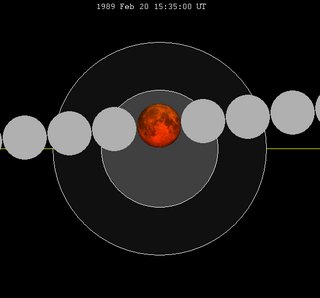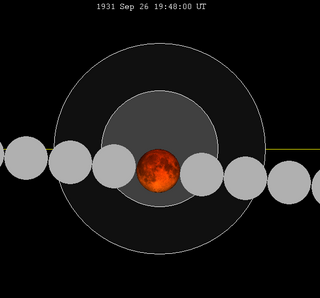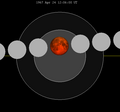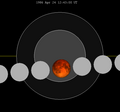Metonic series
This eclipse is the third of four Metonic cycle lunar eclipses on the same date, April 23–24, each separated by 19 years:
The Metonic cycle repeats nearly exactly every 19 years and represents a Saros cycle plus one lunar year. Because it occurs on the same calendar date, the Earth's shadow will in nearly the same location relative to the background stars.
Tritos series
The tritos series repeats 31 days short of 11 years at alternating nodes. Sequential events have incremental Saros cycle indices.
This series produces 23 total eclipses between June 22, 1880 and August 9, 2120.
Half-Saros cycle
A lunar eclipse will be preceded and followed by solar eclipses by 9 years and 5.5 days (a half saros). [2] This lunar eclipse is related to two total solar eclipses of Solar Saros 133.

A total lunar eclipse took place on Sunday, November 9, 2003, the second of two total lunar eclipses in 2003, the first being on May 16, 2003. It is the first total lunar eclipse of 21st century which happened on a micromoon day. The Moon barely edged into total eclipse for 21 minutes and 58 seconds. With the Moon just 1.78% of its diameter into the Earth's umbral shadow, the Moon may have been quite bright, but even so, this should have been worth seeing. The partial eclipse lasted for 3 hours, 31 minutes and 25 seconds. Occurring only 1.4 days before apogee, the Moon's apparent diameter was 6.4% smaller than average.

A total lunar eclipse will take place on Tuesday, March 3, 2026, the first of two lunar eclipses in 2026.

A penumbral lunar eclipse took place on April 24, 2005, the first of two lunar eclipses in 2005. At maximum eclipse, 86.5% of the Moon's disc was partially shaded by the Earth, which caused a slight shadow gradient across its disc; this subtle effect may have been visible to careful observers. No part of the Moon was in complete shadow. The eclipse lasted 4 hours and 6 minutes overall, and was visible from east Asia, Australia, and the Americas.

A penumbral lunar eclipse took place on 14 March 2006, the first of two lunar eclipses in 2006.

A total lunar eclipse took place on Monday, February 20, 1989, the first of two total lunar eclipses in 1989.
A total lunar eclipse took place on Monday, October 28, 1985, the second of two total lunar eclipses in 1985, the first being on May 4, 1985.

A partial lunar eclipse took place on Saturday, December 21, 1991, the last of four lunar eclipses in 1991. The moon grazed the northern edge of the umbral shadow.
A penumbral lunar eclipse took place on Thursday, November 8, 1984, the last of three lunar eclipses in 1984. This subtle penumbral eclipse may have been visible to a skilled observer at maximum eclipse. 90% of the Moon's disc was partially shaded by the Earth, which caused a gentle shadow gradient across its disc at maximum; the eclipse as a whole lasted 4 hours and 28 minutes.
A penumbral lunar eclipse took place on Tuesday, May 15, 1984, the first of three lunar eclipses in 1984. This was a deep penumbral eclipse, with the southern limb of the Moon close to the Earth's shadow.

A partial lunar eclipse occurred on 19 November 2021. The eclipse occurred towards a micromoon. This was the longest partial lunar eclipse since 18 February 1440, and the longest until 8 February, 2669; however, many eclipses, including the November 2022 lunar eclipse, have a longer period of umbral contact at next to 3 hours 40 minutes. It was often referred to as a "Beaver Blood Moon" although not technically fulfilling the criteria for a true blood moon (totality).

A penumbral lunar eclipse will take place on 20–21 February 2027.

A partial lunar eclipse will take place on November 30, 2039. At 3 hours 26 minutes, it is the longest partial lunar eclipse since November 19, 2021, which is the previous member of Lunar Saros 126.

A total lunar eclipse took place on Monday, April 24, 1967, the first of two total lunar eclipses in 1967, the second being on October 18, 1967.
A total lunar eclipse took place on Monday, September 15, 1913. The moon passed through the center of the Earth's shadow.

A total lunar eclipse will take place on September 19, 2043.

A total lunar eclipse will take place on March 13, 2044.

A total lunar eclipse took place on Friday, October 7, 1949, the second of two lunar eclipses in 1949.

A total lunar eclipse took place on Saturday, September 26, 1931. The Moon passed through the central of the Earth's shadow. This was the last central lunar eclipse of Saros cycle 126.

A total lunar eclipse will occur on Wednesday, June 9, 2123, with maximum eclipse at 05:06 UTC. A dramatic total eclipse lasting 106 minutes and 6 seconds will plunge the full Moon into deep darkness, as it passes right through the centre of the Earth's umbral shadow. While the visual effect of a total eclipse is variable, the Moon may be stained a deep orange or red colour at maximum eclipse. This will be a great spectacle for everyone who sees it. The partial eclipse will last for 3 hours and 56 minutes in total. The penumbral eclipse lasts for 6 hours and 14 minutes. Maximum eclipse is at 05:06:28 UT. This will be the longest Total Lunar Eclipse since 16 July 2000, and the longest one until 12 May 2264 and 27 July 3107, though the eclipse on June 19, 2141 will be nearly identical in all aspects. This will also be the longest of the 22nd century and the second longest of the 3rd millennium. The eclipse on June 19, 2141 will be the second longest of the 22nd century and the third longest of the third millennium.

A penumbral lunar eclipse will occur on November 8, 2060. It will be too small to be visually perceptible.


















































































